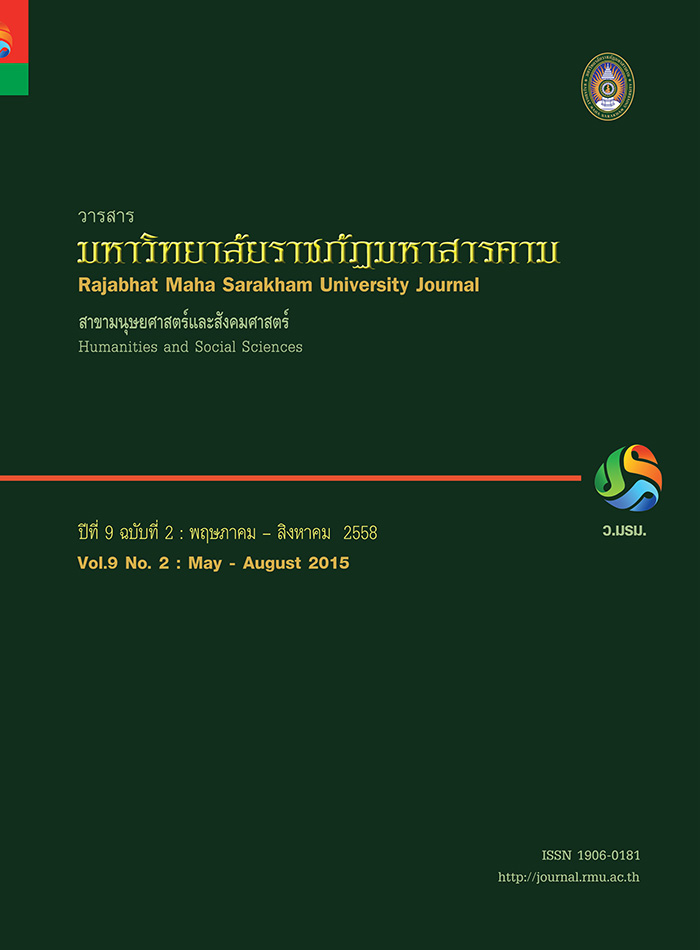บทบาทของผู้นำท้องถิ่นในการจัดการทรัพยากรธรรมชาติและสิ่งแวดล้อมชุมชน : กรณีศึกษาอำเภอประจักษ์ศิลปาคม จังหวัดอุดรธานี;The Roles of Local Leaders in Managing Natural Resources and Community Environment : A Case Study of Prachaksinlapakhom District, Udonthani
Main Article Content
บทคัดย่อ
การวิจัยครั้งนี้มีวัตถุประสงค์เพื่อศึกษาและเปรียบเทียบบทบาทของผู้นำท้องถิ่นในการจัดการทรัพยากรธรรมชาติและสิ่งแวดล้อม
ชุมชน พื้นที่อำเภอประจักษ์ศิลปาคม จังหวัดอุดรธานี โดยทำการศึกษาจากผู้นำท้องถิ่นใน 2 ลักษณะ ได้แก่ ผู้นำโดยโครงสร้าง และ
ผู้นำโดยธรรมชาติ เพื่อนำเสนอรูปแบบการพัฒนาบทบาทของผู้นำท้องถิ่นในการจัดการทรัพยากรธรรมชาติและสิ่งแวดล้อมชุมชน กลุ่ม
ตัวอย่างที่ใช้ในการวิจัยครั้งนี้ ได้แก่ ผู้นำท้องถิ่นอำเภอประจักษ์ศิลปาคม จังหวัดอุดรธานี จำนวน 382 คน เครื่องมือที่ใช้ในการวิจัย
เป็นแบบสอบถาม วิเคราะห์ข้อมูลด้วยการหาค่าร้อยละ ค่าเฉลี่ย ค่าเบี่ยงเบนมาตรฐาน และการทดสอบสมมติฐานโดยการทดสอบค่าที
(t-test) และการวิเคราะห์ความแปรปรวน (ANOVA) ผลการวิจัยพบว่า
1. บทบาทของผู้นำท้องถิ่น อำเภอประจักษ์ศิลปาคม จังหวัดอุดรธานี โดยภาพรวมอยู่ในระดับมาก เมื่อแยกพิจารณาเป็นราย
ด้านพบว่า อยู่ในระดับมากทุกด้าน และมีความต้องการจัดการทรัพยากรธรรมชาติและสิ่งแวดล้อมชุมชน โดยภาพรวมอยู่ในระดับมาก
เมื่อแยกพิจารณาเป็นรายด้านพบว่า มีความต้องการอยู่ในระดับมากในทุกด้าน
2. ผู้นำโดยโครงสร้างและผู้นำโดยธรรมชาติ โดยภาพรวมมีบทบาทอยู่ในระดับมาก เมื่อแยกพิจารณาเป็นรายด้านพบว่า ด้าน
การป้องกันทรัพยากรธรรมชาติและสิ่งแวดล้อมชุมชนแตกต่างกันอย่างมีนัยสำคัญทางสถิติที่ระดับ .05 และมีความต้องการของผู้นำ
ท้องถิ่นทั้ง 2 กลุ่ม พบว่า ความต้องการในการพัฒนาบทบาทของผู้นำท้องถิ่นในการจัดการทรัพยากรธรรมชาติและสิ่งแวดล้อมชุมชน
โดยภาพรวมแตกต่างกันอย่างนัยสำคัญทางสถิติที่ระดับ .05
ผลจากการวิจัย ผู้วิจัยสามารถนำมาเสนอรูปแบบแนวทางในการกำหนดยุทธศาสตร์การพัฒนาบทบาทผู้นำท้องถิ่นออกเป็น 3
ยุทธศาสตร์หลัก ได้แก่ ยุทธศาสตร์การพัฒนาความรู้ความเข้าใจในการจัดการทรัพยากรธรรมชาติและ
สิ่งแวดล้อมชุมชน ยุทธศาสตร์การมีส่วนร่วมของผู้นำท้องถิ่นในการจัดการทรัพยากรธรรมชาติและสิ่งแวดล้อมชุมชน และยุทธศาสตร์
การกำกับ ดูแลของผู้นำท้องถิ่นในการจัดการทรัพยากรธรรมชาติและสิ่งแวดล้อมชุมชน
The purposes of this research were to study and compare the roles of local leaders in managing natural
resources and community environment: a case study of Prachaksinlapakhom District, Udonthani Province. For this
study two dimensions of local leaders’ characteristics were studied: leaders by structure and leaders by nature;
the aim was to present a model and strategic guidelines for developing local leaders in managing natural resources
and community environment.. The sample population for this research were 382 local leaders in Prachaksinlapakhom
District, Udonthani. The instrument for this research was a questionnaire and the statistics used in analyzing the
data were percentage, mean and standard deviation while the hypothesis was tested by using t-test and ANOVA
Findings of the study were as follows:
1. The overall roles of local leaders in Prachaksinlapakhom District, Udonthani were found at the high
level, and the roles regarding each of the specific aspects were also found at the high level. In addition, the
overall need regarding local leaders’ roles in managing natural resources and community environment was
found at the high level, and the needs for leaders’ roles in specific areas were also shown at the high level.
2. Regarding the two dimensions of leaders’ characteristics, leaders by structure and leaders by
nature, the study revealed that the overall characteristics of their roles were found at the high level. And
when specific aspects were studied, it was found that the aspects regarding protection of natural resources
and community environment were statistically different at the .05 level of significance. As for the needs of
local leaders, the study revealed that the overall needs for role development of the two groups in managing
natural resources and community environment were statistically different at the .05 level of significance.
These research findings can provide guidelines for setting strategies for developing local leaders’
roles, which can fall into three categories as follows: Strategy for developing knowledge and understanding
management of natural resources and community environment; Strategy for local leaders’ participation in
management of natural resources and community environment, and Strategy for regulating and monitoring
management of natural resources and community environment.
Article Details
1. บทความที่ลงตีพิมพ์ทุกเรื่องได้รับการตรวจทางวิชาการโดยผู้ประเมินอิสระ ผู้ทรงคุณวุฒิ (Peer Review) สาขาที่เกี่ยวข้อง อย่างน้อย 3 ท่าน ในรูปแบบ Double blind review
2. ข้อคิดเห็นใด ๆ ของบทความที่ลงตีพิมพ์ในวารสารมหาวิทยาลัยราชภัฏมหาสารคาม นี้เป็นของผู้เขียน คณะผู้จัดทำวารสารไม่จำเป็นต้องเห็นด้วย
3. กองบรรณาธิการวารสารมหาวิทยาลัยราชภัฏมหาสารคาม ไม่สงวนสิทธิ์การคัดลอกแต่ให้อ้างอิงแสดงที่มา


